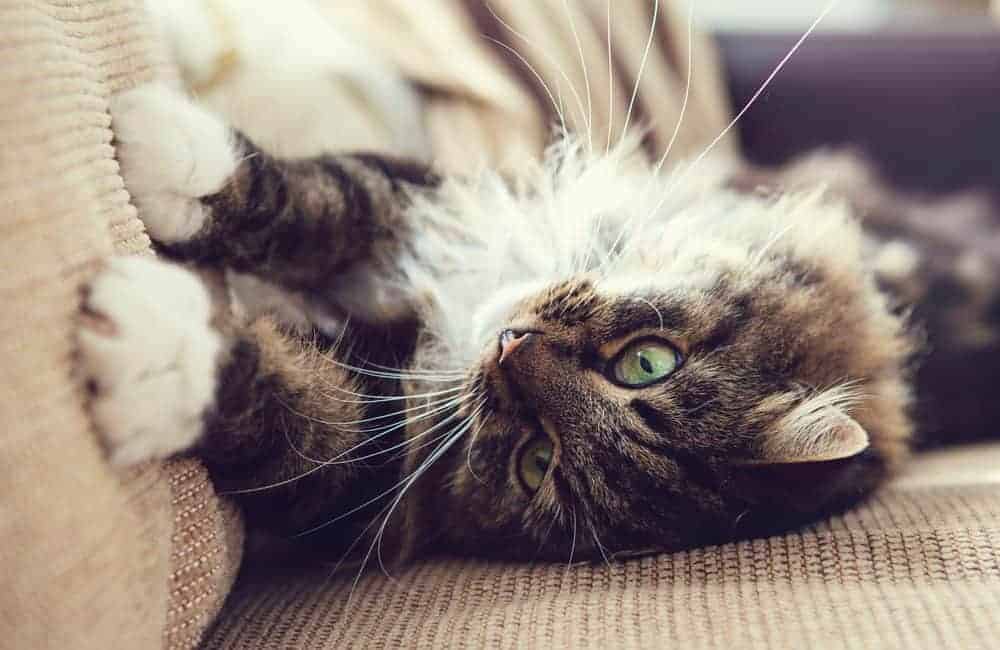
Your cat wants to get one thing straight with you – he or she does not scratch the furniture just to annoy you. Scratching stuff is an essential part of being a cat and it fulfils several very important functions.
Keeping claws in optimum condition
Cats scratch with their front claws by dragging them downward, either on a horizontal or vertical surface. This action, referred to as stropping, loosens and removes the outer husk of the claw revealing a beautifully sharp new surface underneath.
Toning up
Scratching exercises the muscles of the forelimbs and spine, which helps keep the cat in prime hunting condition. Another tone-up routine you may have observed can involve the cat scratching by lying down, gripping the carpet with their claws and pulling their bodyweight along the floor.
Marking territory
Scratching is also used as a form of territorial communication. Scent and sweat glands in between the pads of the feet produce a unique smell. When claws are scraped down a surface, the scent is deposited. The cat has left a mark to say this is mine!
Seeking attention
Some cats quickly cotton on to the fact that scratching will bring them attention from their human – even if it’s a ‘stop that!’. It may also be a precursor to wanting to play some stalking, chasing and swatting games. Ignore them when they scratch inappropriate object and divert their attention to their scratching post via a chasing game, praising them when they use it.
Confidence versus insecurity
Every cat is an individual. While a confident cat who feels happy in its space may scratch more vigorously in the presence of its human just to show how chilled out they are, for other felines, widespread scratching around the home, particularly around doorways and windows, could signal that they are feeling stressed and insecure.
If this is the case with your cat, it’s your job to help them feel more safe and secure – and is why you should never tell them off for scratching. Your cat should always see you as a source of security, not a potential threat.
Help your cat feel secure
If you suspect your cat is scratching out of insecurity, the charity International Cat Care recommends trying the following strategies:
Identify the cause
Try to work out what could be the causing stress or insecurity. Could it be strange cats coming into the house (time to introduce a micro-chipped, secure cat flap?), conflict between resident cats, or changes within the household – is there a new person around, or have you redecorated or bought new furniture that smells unfamiliar? Perhaps your cat is reacting to something outside – such as an unfriendly feline entering your pet’s territory.
Provide safe spots
Cats like to be up high where they can observe what’s going on while feeling safe. Provide some cat-accessible areas – such as space on a roomy bookshelf or top of a cupboard, where your cat can rest and relax, safely off the ground.
Use your cat’s own scent
Cats use their cheek glands to mark their territory and the presence of these scents will make them feel relaxed. You can help spread scent by taking a soft cloth and wiping it around your cat’s face. Dab the cloth around the room where you have seen your cat rubbing and where the cat scratches.
Try cat scent products
Many people find that specially developed scent products, that mimic natural ‘happy’ pheromones such as Feliway or Pet Remedy, can be very beneficial, as these provides a sense of security and reassurance to the cat, making scratching for territorial reasons less likely to occur.
Practical cat-scratching magic
Animal Charity Blue Cross recommends the following tips for managing your cat’s scratching behaviour:
Provide a scratching post and make it tempting
Scratching posts must be vertical, with a heavy, sturdy base, and at least 90 cm tall, to allow a full-body cat stretch. If you have more than one cat, provide each with their own post. Place the post in front of the damaged area, gently wipe the cat’s paws down the post to leave some scent on it and show the cat what to do. Do this several times when the post is new. If you catch your cat in the act of scratching elsewhere, carry the cat to the post and encourage them to scratch there instead. Make the post more irresistible by sprinkling cat nip on it, putting a little dry food on it, or by attaching a toy or feathers to the top.
Introduce more playtime
Try playing with your cat more regularly, little and often throughout the day, providing toys which offer an outlet for hunting behaviours.
Remove your cat’s scent
If scratching is used as a form of marking territory, then the cat will be attracted back to the spot to top up the marks as the scent wears off. If this is an area where you want to stop the cat scratching and the surface is cleanable, then remove the scent using a mild solution of a biological washing powder and then scrubbing with surgical spirit (check that this will not remove colour from fabrics). Keep your cat well away from the area until it is dry.
Stick up a deterrent
If there’s a particular piece of furniture your cat is attracted to, but you beg to differ on its suitability for scratching, stick some double-sided adhesive tape on the area. This will provide an unpleasant, but not dangerous experience when your cat next scratches there. Remember to place an alluring scratching post nearby and positively divert their attention to that.
FIND OUT MORE about how cat friendly your home is here
FIND OUT MORE about puzzling cat behaviour here
Sources: icc.org.uk, bluecross.org.uk, cats.org.uk














